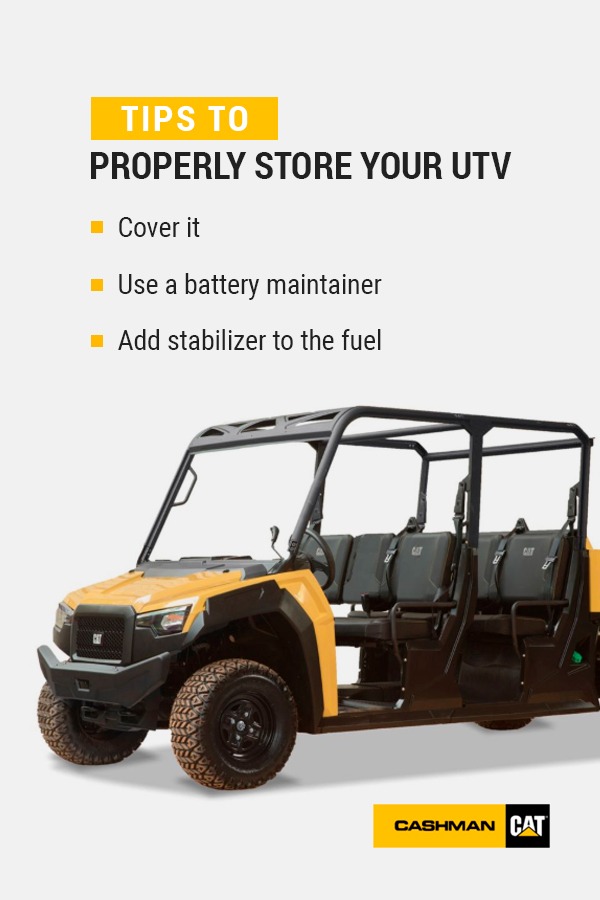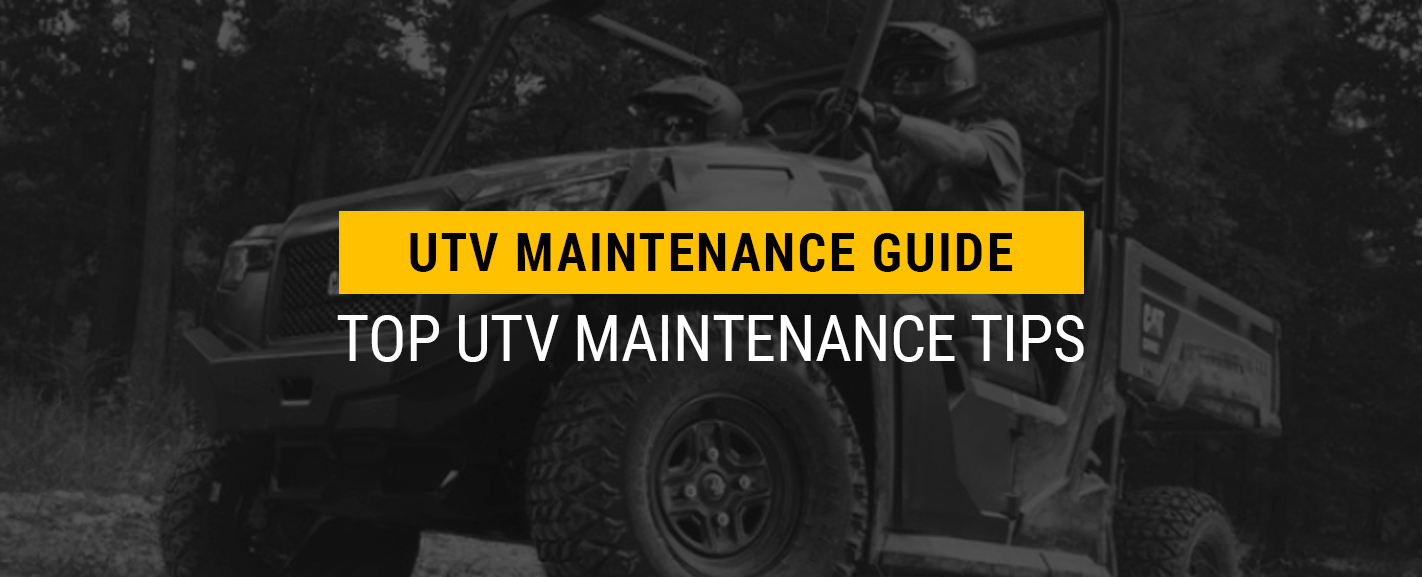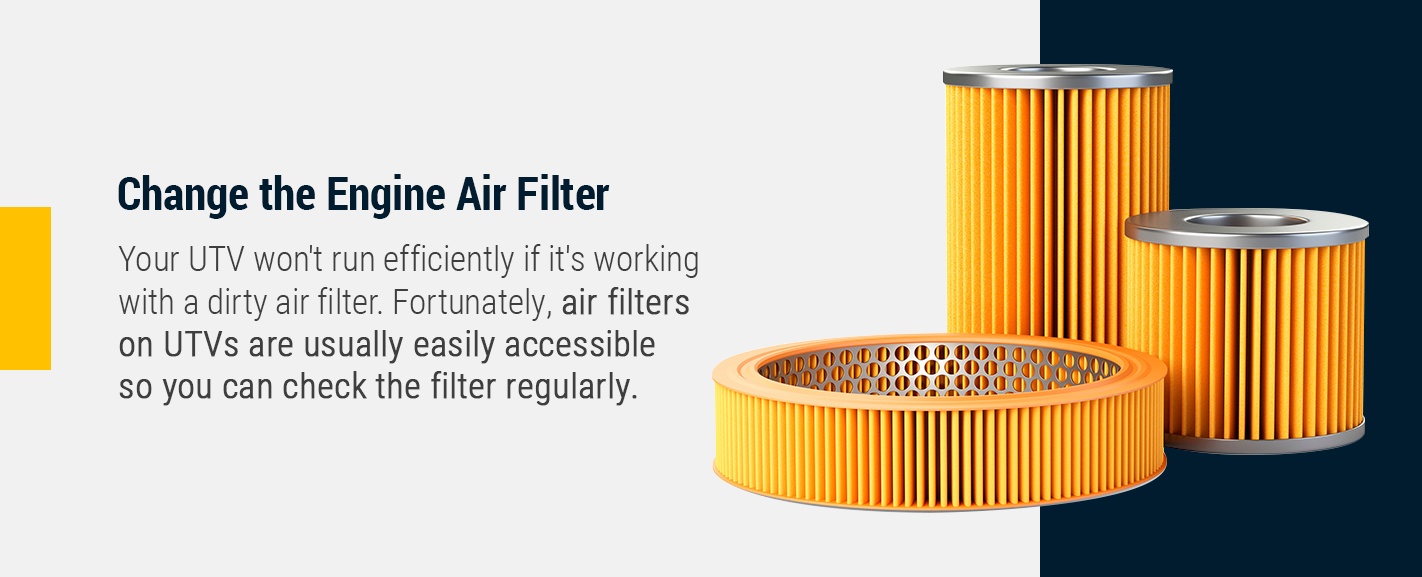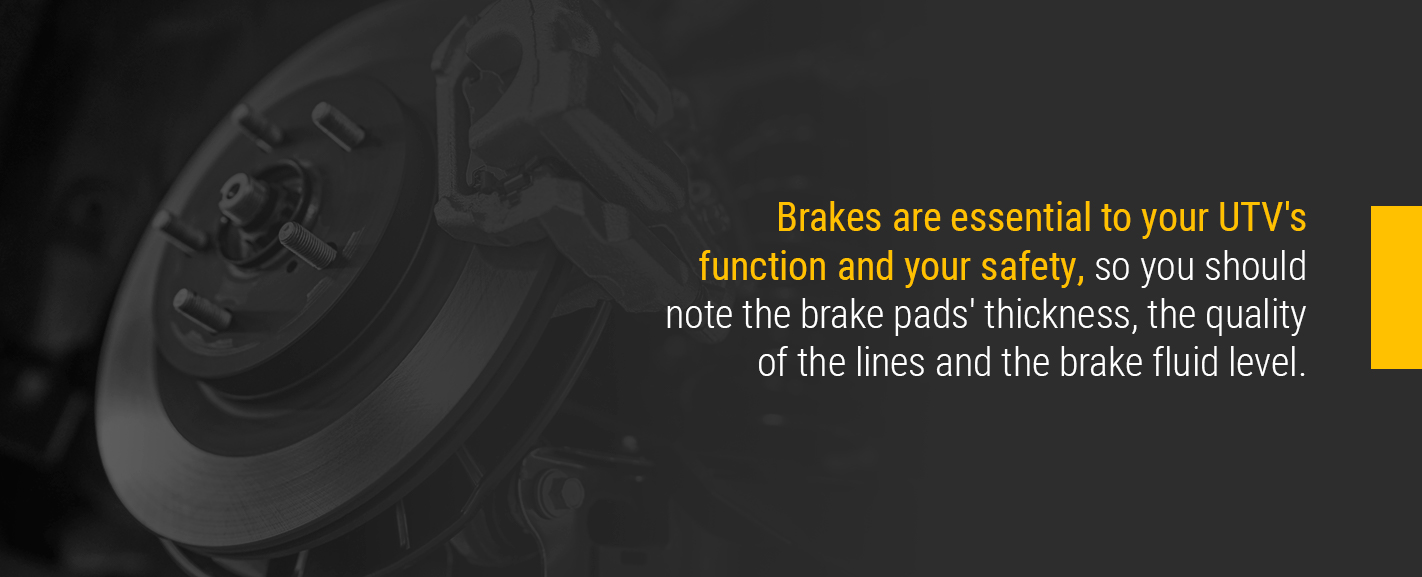UTV can stand for utility task vehicles, utility terrain vehicles, or simply utility vehicles. You may also see a UTV referred to as a side-by-side. Whatever you call it, a UTV can be a game-changer when it comes to getting around on a job site or hauling equipment when you’re off-road. It can also serve as a recreational vehicle when you’re ready for a bit of fun. If you’ve already invested in a UTV, then you know what we mean.
When you’ve come to count on the help of a UTV to get the job done or to blow off some steam, you don’t want to run into a maintenance problem that takes your UTV out of commission unexpectedly. We’re going to explain how to maintain your UTV proactively so you can keep it in excellent working condition.
Top 10 Maintenance Tips for Your UTV
Every UTV is different, so you should consult your manufacturer’s manual and listen to any advice from your dealer to help you give your UTV the maintenance it needs to stay in great shape. If you have a Cat® UTV, you can find a planned maintenance schedule online to help you stay on top of your UTV’s service needs.
However, there are some basic maintenance tasks that all UTV owners should prioritize. These are all important ways to keep your UTV in good condition.
1. Change the Oil and Oil Filter
One of the most important maintenance tasks for your UTV is to top off the oil as needed and change out the oil and oil filter regularly. This is a more obvious maintenance task for most UTV owners, but it’s still easy to neglect. It’s best to check your oil levels every time before taking your UTV for a ride or out on the job so you never put unnecessary strain on your engine.
When you need to add oil, be careful not to overfill it since too much oil can cause the engine to run hot. This is easy to do in a UTV since it holds a much smaller amount of oil than your car does.
2. Check the Coolant Level
You also need to keep a close eye on your engine coolant and add coolant whenever needed. Unlike the oil, you don’t need to check on the coolant before every ride, but you don’t want to go long periods without checking. The coolant reservoir can be tricky to get to, but you’ll still want to check it regularly.
While you’re at it, inspect the lines and fittings to make sure they’re in good shape. The radiator cap should be free of any cracks or breaks so it can maintain a consistent flow of coolant to your engine. Maintaining the cooling system will help you keep the seals cooled and lubricated and ultimately extend your UTV’s engine life.
3. Change the Engine Air Filter
Another aspect of your engine you need to maintain is the air filter. Your UTV won’t run efficiently if it’s working with a dirty air filter. Fortunately, air filters on UTVs are usually easily accessible so you can check the filter regularly. When you check your filter, also pay attention to the condition of the filter box, which could get some dirt or debris in it you need to clean out.
Make sure you know whether you have a serviceable air filter or not. In other words, is your filter reusable or disposable? If you have a disposable filter, you’ll need to buy a new one or switch to a serviceable filter you can clean and keep using.
4. Keep the Fittings Lubricated
Anywhere there are pivot points on your vehicle, you should see grease fittings, also known as zerk fittings, protruding out slightly from your vehicle. These fittings can help you keep your UTV working smoothly, as long as you oil them.
You can use a grease gun to keep your fittings well-lubricated. Your manufacturer should recommend what type of grease to use, and should also tell you where all the grease fittings are located on your UTV. Make sure you do this regularly since it’s a fairly easy task and help you proactively maintain your UTV.
5. Change the Spark Plugs
Your manufacturer should recommend how often you need to change your UTV’s spark plugs. Keep in mind that these recommendations are based on an engine that’s in good working order and on an average amount of wear. If your UTV experiences a lot of wear and tear, you may need to change out the spark plugs more often — especially if you notice your UTV isn’t running like it used to.
If the spark plug is corroded or fouled with carbon, this can indicate a problem with the engine, so it’s a good idea to take your UTV to a mechanic. If you replace the spark plugs yourself, make sure you use a feeler gauge to get the gap just right according to the manufacturer’s recommendation.
6. Inspect the Tires
UTVs only perform as the great off-road vehicles they are if the tires are in good shape. Especially if your UTV has been sitting in storage for a while, you’ll want to check the tired before taking it out. Tires can naturally lose air pressure over time, so you’ll probably need to add some air. If a tire has been flat for a while, you could see some damage in the sidewall.
Use a pressure gauge to get an accurate read on your tire pressure and then use it again to help you add the right amount of air. Your owner’s manual should tell you the proper levels to shoot for. If you over-inflate your tires, your tires’ tread can wear unevenly. Pay attention to your tires’ tread so you know when it’s time to replace the tires.
7. Check the Fuel
If you’re using your UTV frequently, checking the gas just means making sure you have enough fuel to get around before you ride off. If your UTV has been in storage for a while, though, you should check the gas to see whether it’s gone bad. Fuel that has been sitting in the gas tank for a while can go bad because parts of the fuel evaporate, leaving it thick and gummy.
The simplest way to check to make sure the gas is still good is to smell it. If it seems off, drain the tank and clean out the fuel system before refilling the tank with new gas. Don’t run the UTV with bad gas in it since this can cause damage to the UTV. Consider paying a bit more for higher quality, high-octane fuel that will keep your system running in tip-top condition.
8. Maintain or Replace the Battery
Another issue you can experience when you leave your UTV in storage for a long time, such as during the winter, is a bad battery. To keep functioning, a battery needs to charge regularly. Leaving the UTV to sit also means leaving the battery to sit, and this is likely to leave you with a dead battery when you go to fire up your UTV again. This scenario often necessitates getting a new battery.
So, how can you avoid this problem? An easy solution is to set up a battery maintainer to keep your battery charged while the UTV is in storage. You should still check the status of your battery regularly and inspect for corrosion around the terminals or low electrolyte levels in the case of an unsealed battery. Keep your battery well-maintained to extend its life as long as possible.
9. Check the Brakes
Brakes are essential to your UTV’s function and your safety, so you should check the brakes regularly to make sure they’re in good working order. Note the brake pads’ thickness, the quality of the lines and the brake fluid level. Also, check to make sure the fluid is in good condition and there isn’t any debris contaminating the reservoir.
If anything ever feels unusual with your brakes or you notice some signs of damage when you conduct your inspection, take your UTV to a professional mechanic to have it serviced. Brakes are not typically something you want to repair or replace on your own.
10. Replace the Belt
It’s a good idea to inspect your UTV’s drive system. For most UTVs, this is a CVT belt drive system. The belt can endure a lot of wear and tear, but it eventually needs replacing, so you should check on its condition occasionally. You should check the tension and look for any signs of wear and tear like glazing or cracking that can indicate it’s time for a replacement.
You’re better off to replace the belt before it fails completely and stops you in your tracks. How often you need to replace the belt will depend on how often and how hard you run your UTV.
Remember to Clean Your UTV
Maintenance doesn’t only consist of inspecting and servicing the inner workings of your UTV. You also want to keep it looking great on the outside. This means cleaning your UTV regularly. Cleaning isn’t just about looks. It’s also an important form of preventative maintenance to help you avoid problems like rust and contamination that can happen if you leave your UTV caked in mud.
To clean your UTV, first, get off as much of the mud as you can by just scraping at it. Then, you can wash the vehicle with soapy water. Opt for a mild detergent that won’t cause any corrosion. Finish by rinsing and drying the UTV.
You can help your UTV continue to look its best by polishing it and adding a protective coating. This coating will make it harder for mud and other debris to stick to it the next time you take it out.
How to Properly Store Your UTV
We’ve already mentioned some maintenance tasks that become especially important when you’re storing your UTV for longer stretches of time. When you’re putting your UTV away for the season, make sure you:

- Cover it: If possible, store your UTV inside a storage shed or garage where it can stay dry and protected from harsh temperature changes. Use a cover made from breathable material so any moisture underneath can evaporate rather than get stuck inside and cause your UTV to rust.
- Use a battery maintainer: If you want to keep your battery working, hook it up to a device that will top off the charge as needed. This extra step can pay off in a big way since otherwise, you may find a dead battery that needs to be replaced when you try to start it up later.
- Add stabilizer to the fuel: If you leave your UTV sitting for long periods, you may want to use a fuel stabilizer to help prevent the gas from going bad. This is always a good idea if you’re storing your UTV for the winter and have some gas still in the tank.
Cat® UTV Parts and Service Available at Cashman Equipment
When it comes time to give your UTV a little TLC, you need the right parts and the right expertise to get the job done. Buying parts online comes with some serious perks, so it’s smart to find a site that will let you do this, like Cashman Equipment. You can also find how-tos online that can help you do repairs on your own, but in many cases, you’re better off trusting the professionals to take care of your UTV’s service needs.
You can take care of some basic UTV maintenance on your own, but any time you think your UTV is running into a serious problem or you’re not sure what’s wrong with it, you should play it safe and trust the experts.
At Cashman Equipment, we carry a wide range of parts for Cat UTVs, and we can also inspect and repair your UTV whenever it needs it. We provide full parts and service support for Cat UTVs, so you can count on us to help take care of all your side-by-side vehicle’s maintenance needs.
Cat UTVs From Cashman Equipment
If you’re looking to buy a new Cat UTV, we can help you with that, too. Whether you’re looking to become a UTV owner for the first time, want to add to your collection of off-road vehicles or needing some help with parts and service, we’ve got you covered. We’ve been an authorized Cat dealer in Nevada for almost 90 years, so you can put your confidence in us to get you the vehicles, equipment and maintenance services you need, all with exceptional customer service.
To learn more about our Cat UTVs, contact us online or give us a call at 800-937-2326. Or, you can stop into one of our locations across Nevada and the Eastern Sierras. We’re here to help you ride confidently off-road.





